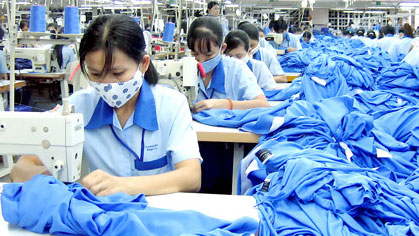Spike predicted in Korean investment
The Republic of Korea (RoK)’s direct investment inflow to Vietnam is expected to soar in the near future, as businesses scramble to capitalise on the recently-signed free trade agreement between the two countries.
“We see multiple opportunities arising from the recent ratification of the free trade agreement (FTA) between our countries, which is why we have chosen to build out factory in Vietnam,” said Kim Duk Yong, chairman of KMW-RoK’s biggest maker of telecommunications and LED lighting equipment.
He made this statement at a recent groundbreaking ceremony for its US$100 million manufacturing plant in the northern province of Ha Nam.
At the ceremony, Vietnamese Deputy Prime Minister Hoang Trung Hai and the RoK’s Ambassador to Vietnam Jun Dae Joo said they both anticipated a jump in the RoK’s investment to Vietnam after the recent signing of the bilateral FTA.

According to Hong Sun, general secretary of the Korean Chamber of Commerce in Vietnam, in addition to industry, agriculture is also expected to receive a lot of attention from Korean investors.
“Many RoK’s investors want to step into Vietnam’s agriculture sector, and so the number of investors may spike following the signing of the bilateral FTA. Through their operations in Vietnam, the RoK’s investors will export products back to the RoK to cash in on low tariff rates arising from the FTA,” said Sun.
“In addition, the bilateral FTA allows very low tariffs for Vietnam to import garment materials and accessories from the RoK, this will inspire Korean firms to further pump up their investment in this field for export back to the RoK and other markets,” he added.
His comment has been backed up by a string of new RoK’s investment projects in Vietnam’s textile and garment sector over recent months.
For instance, earlier this month, authorities in the southern province of Dong Nai granted an investment certificate to Hyosung Dong Nai-part of Hyosung Corporation-to invest more than VND14 trillion (US$660 million) to build a fibre production plant on 22 hectares in the province’s Nhon Trach 5 Industrial Zone.
A textile-garment-dyeing factory valued at US$30 million invested in by the RoK’s garment and textile group Panko was licensed not long ago in the central province of Quang Nam.
Other projects include In Kyung Apparel’s US$5.1 million project, a US$20 million project by S&H Vina, and an US$8.5 million project by Viet Pan-Pacific in the northcentral province of Thanh Hoa, to name just a few.
Meanwhile, ACE Technologies Corporation-a Korean leader in the manufacture of radio frequency components, base station antennae, mobile antennae, repeaters, telematics, and future media concepts, last week was licensed to build a US$60 million plant producing wireless antennae for smartphones in Ha Nam.
“The ratification of the Vietnam-RoK FTA will inspire Korean investors with delayed projects in Vietnam, and will convince those still unsure about their investment decisions to become more determined to invest in Vietnam,” said Nguyen Mai, chairman of the Vietnam Association of Foreign Invested Enterprises.
The RoK’s is currently Vietnam’s biggest foreign investor. As of April 20, 2015, the RoK’s total cumulative investment capital here surpassed US$38.5 billion.
